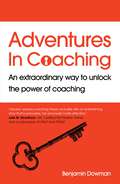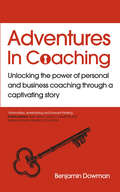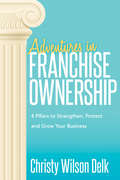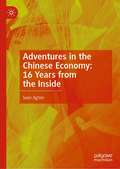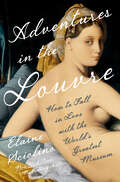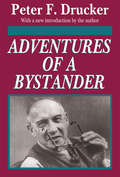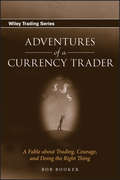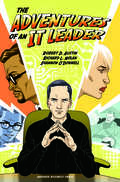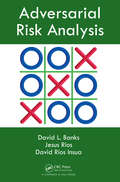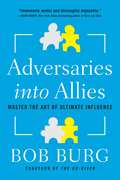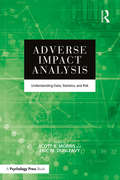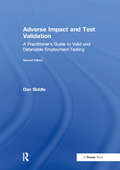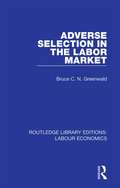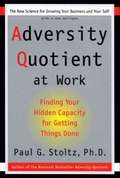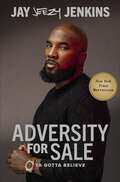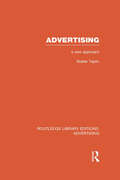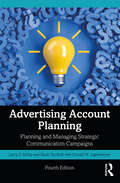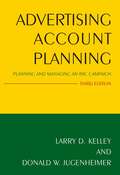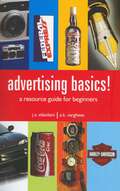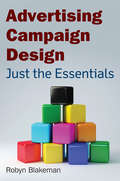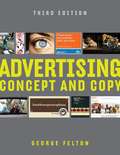- Table View
- List View
Adventures in Coaching: Unlocking the power of personal and business coaching through a captivating story
by Ben Dowman**Discover the power of coaching through an entertaining and lively story that will develop the skills and understanding of how to coach effectively.** In this groundbreaking new approach to learning how to coach, join Alice on an adventure as she learns the fundamental principles of personal and business coaching. Meet a host of fanciful characters who will help you understand how to listen, how to ask questions effectively and how to have a coaching conversation from start to finish.Adventures in Coaching introduces Coaching as an approach for managing people, improving performance and solving problems. Research shows that learning is often better retained when made fun and stimulating. This book delivers the most rigorous and advanced textbook coaching theory, including the GROW model, in a uniquely engaging and mesmerising manner. The structure and sequence of the material is based on a tried and tested progression that the author has refined through his training and workshops with hundreds of people.The book is brought to life through relevant coaching conversations and practical examples as Alice puts her learning into practice. "Why are you talking about me in the third person, Ben? I'm right here." "Alice! Hello. I'm just introducing the book." "Have you said that I'm the star of the story?" "Of course, Alice." "Ben, can I introduce Rita and Ronald?" "Er... well... I'm not sure we should start with talking animals, this is a serious book." "Of course we should. Rita is a turtle who is an expert coach and she taught Ronald and I how to coach. Oh, and Ronald is a fish!" "Thank you, Alice!" Coaching is brought to life when Alice is faced with some tough coaching conversations and she applies her new learning to the clients she works with. Both new and existing coaches, as well as managers and leaders, will improve their skills of listening, asking questions and exploring ideas. "Good job, Ben. I can't wait to tell the story."
Adventures in Coaching: Unlocking the power of personal and business coaching through a captivating story
by Ben DowmanThis enchanting story uses Lewis Carroll's Alice's Adventures in Wonderland to explain personal and business coaching in a magical and entertaining adventure. A host of fanciful characters show readers how to have an effective coaching conversation from start to finish, and to reach real world outcomes in a more transformative way.In this captivating story, Alice finds herself turning into a pizza, going straight to jail on the Monopoly board and embarking on a space flight. Along the way she meets a helpful turtle, a charismatic ladybird and a fox with some personal problems, among a cast of curious characters.Research shows that learning is often better retained when made fun and stimulating. This book delivers the most rigorous and advanced textbook coaching theory, including the GROW model, contracting and feedback, in a uniquely engaging and mesmerising manner. The structure and sequence of the material is based on a tried and tested progression that the author has refined through his training and workshops over many years.This groundbreaking approach to learning to coach will do for coaching what Who Moved My Cheese did for managing change.
Adventures in Franchise Ownership: 4 Pillars to Strengthen, Protect and Grow Your Business
by Christy Wilson DelkWritten in the style of a business &‘tell-all&’, Adventures in Franchise Ownership lays out what successful franchisees do that you won&’t find in most owner&’s manuals and includes franchisee Christy Wilson Delk&’s good, bad, and really tough days before her successful exit 15 years later. Franchisees, like most small business owners, experience times of extreme frustration, lapses in motivation, and often exit before reaching their potential and their goals. Based on Christy&’s real-life franchise ownership adventures, this guide explains how her 4 Pillar to Pillars Approach helps all franchise owners get to the top tier of their franchise system and includes advice from 16 top performers representing over a dozen market segments. With humor, candor, and relatability, Christy fills in the gaps of the franchise Owner&’s Manual by providing a constructive framework for finding professional satisfaction and attaining the financial success franchise owners everywhere want and deserve.
Adventures in the Chinese Economy: 16 Years from the Inside
by Sven AgtenThis book provides an insightful overview of the social-economical trends in modern China, their global influence, and the disrupting consequences for businesses and countries all over the world. It is a fresh look at the business conditions that Western firms face in China, poised to become the world's largest and most dynamic economy. Using a vast array facts and data, combined with personal stories and experiences, Mr. Agten provides an accessible and entertaining glimpse at Chinese megatrends, such as the development of the middle class, innovation and upskilling, digitalization of Chinese society, rising labor costs and more. This book is a must-read for entrepreneurs, executives and economists seeking to understand the Chinese market.
Adventures in the Louvre: How to Fall in Love with the World's Greatest Museum
by Elaine SciolinoA former New York Times Paris bureau chief explores the Louvre, offering an intimate journey of discovery and revelation. The Louvre is the most famous museum in the world, attracting millions of visitors every year with its masterpieces. In Adventures in the Louvre, Elaine Sciolino immerses herself in this magical space and helps us fall in love with what was once a forbidding fortress. Exploring galleries, basements, rooftops, and gardens, Sciolino demystifies the Louvre, introducing us to her favorite artworks, both legendary and overlooked, and to the people who are the museum’s lifeblood: the curators, the artisans producing frames and engravings, the builders overseeing restorations, the firefighters protecting the aging structure. Blending investigative journalism, travelogue, history, and memoir, Sciolino walks her readers through the museum’s front gates and immerses them in its irresistible, engrossing world of beauty and culture. Adventures in the Louvre reveals the secrets of this grand monument of Paris and basks in its timeless, seductive power.
Adventures of a Bystander
by Peter DruckerPeter Drucker's lively and thoughtful memoirs are now available in paperback with a new introduction by the author. He writes with wit and spirit about people he has encountered in a long and varied life, including Sigmund Freud, Henry Luce, Alfred Sloan, John L. Lewis, and Marshall McLuhan. After beginning with his childhood in Vienna during and after World War I, Drucker moves on to Europe in the 1920s and early 1930s, describing the imminent doom posed by Hitler and the Nazis. He then goes on to describe London during the 1930s, America during the New Deal era, the World War II years, and beyond.According to John Brooks of The New York Times Book Review, "Peter Drucker is at a corner cafe, delightfully regaling anyone who will listen with tales of what must be one of the more varied—and for a practitioner of such a narrow skill as that of management counseling, astonishing—of contemporary professional lives." Dorothy Rabinowitz of the Washington Post writes, "The famous are here as well as the infamous.... All are the beneficiaries, for better or for worse, of Drucker's unerring eye for psychological detail, his remorseless curiosity, and his imaginative sympathy.... Drucker's book appears in a stroke to have restored the art of the memoir and of the essay."Adventures of a Bystander reflects Drucker's vitality, infinite curiosity, and interest in people, ideas, and the forces behind them. His book is a personal and informal account of the rich life of an independent man of letters, a life that spans eight decades and two continents. It will be of interest to scholars and professionals in the business world, historians, sociologists, and admirers of Peter Drucker.
Adventures of a Currency Trader
by Rob BookerPraise for ADVENTURES of a CURRENCY TRADER "A truly easy, unique, and enjoyable read! Rob has done it once again to teach us in the funniest way possible how not to make the most common trading mistakes. If you are tired of reading how-to books, this is perfect for you. I highly recommend this book to all traders. Everyone will learn something about themselves by reading this book. " -Kathy Lien, author, Day Trading the Currency Market, and Chief Strategist, www. dailyfx. com "Adventures of a Currency Trader is a must read for anyone who has ever traded or is thinking about trading in the Forex markets. Rob Booker has a unique way of taking years of market knowledge and transforming it into an educational and entertaining experience. It has quickly become a cult classic in my trading library!" -H. Jack Bouroudjian, Principal, Brewer Investment Group "Brilliant! Rob's humor and humanity shine through in this parable about trading and life. Filled with wisdom and wit, it's an exhilarating rollercoaster ride through the peaks and valleys of the learning curve, with many valuable lessons learned along the way. " -Ed Ponsi, President, FXEducator. com "Rob's fable of everyman 'Harry Banes' is destined to become a trading classic. This is both the missing piece and the foundation that comes before the strategies and methodologies. The search for the Holy Grail begins and ends in the heart and mind. The journey is authentic and real and if you're willing to take it with Rob, you will be rewarded in the end. Seldom has psychology and wisdom been so entertaining!" -Raghee Horner, trader and author of Forex Trading for Maximum Profit and Days of Forex Trading "In a series of insightful and entertaining vignettes, Rob Booker teaches both the novice and the experienced trader some hard won truths about the currency market. It's a must read book written by a guy who survived the trenches and went on to prosper in the biggest and most competitive financial market in the world. " -Boris Schlossberg, Senior Currency Strategist, Forex Capital Markets LLC, and author of Technical Analysis of the Currency Market
Adventures of an It Leader
by Robert D. Austin Richard L. Nolan Shannon O'DonnellBecoming an effective IT manager presents a host of challenges--from anticipating emerging technology to managing relationships with vendors, employees, and other managers. A good IT manager must also be a strong business leader.This book invites you to accompany new CIO Jim Barton to better understand the role of IT in your organization. You'll see Jim struggle through a challenging first year, handling (and fumbling) situations that, although fictional, are based on true events.You can read this book from beginning to end, or treat is as a series of cases. You can also skip around to address your most pressing needs. For example, need to learn about crisis management and security? Read chapters 10-12. You can formulate your own responses to a CIO's obstacles by reading the authors' regular "Reflection" questions.You'll turn to this book many times as you face IT-related issues in your own career.
Adversarial Reasoning: Computational Approaches to Reading the Opponent's Mind (Chapman & Hall/CRC Computer and Information Science Series)
by Alexander Kott William M. McEneaneyThe rising tide of threats, from financial cybercrime to asymmetric military conflicts, demands greater sophistication in tools and techniques of law enforcement, commercial and domestic security professionals, and terrorism prevention. Concentrating on computational solutions to determine or anticipate an adversary's intent, Adversarial Reasoning:
Adversarial Risk Analysis
by David L. Banks Jesus M. Aliaga David Rios InsuaWinner of the 2017 De Groot Prize awarded by the International Society for Bayesian Analysis (ISBA)A relatively new area of research, adversarial risk analysis (ARA) informs decision making when there are intelligent opponents and uncertain outcomes. Adversarial Risk Analysis develops methods for allocating defensive or offensive resources against
Adversaries into Allies
by Bob BurgThe Sages asked, "Who is mighty?" and answered, "Those who can control their own emotions and make of an enemy a friend. " In the bestselling book The Go-Giver, Bob Burg and John David Mann revolutionized the way we think about success via one very simple lesson: "Shifting one's focus from getting to giving (constantly and consistently providing value to others) is both very fulfilling and the most profitable way to do business. Now Burg is back with a new book, offering deeper insight into what it means to be truly influential and providing powerful strategies for mastering the art of winning people over. Faced with the task of persuading someone to do what we want, most of us expect, and often encounter, resistance. We see the other person as an adversary and often resort to coercion or manipulation in order to get our way. But while this approach might at times bring us short-term results, it leaves people with a bad feeling about themselves and about us. At that point, our relationship with the person is weakened and our influence dramatically decreased. There is a better way. Drawing on his own experiences and the stories of other influential people, Burg offers five simple principles of what he calls Ultimate Influence-the ability to win people to your side in a way that leaves everyone feeling great about the outcome . . . and about themselves!: Control your own emotions: Responding calmly rather than allowing your emotions to get the better of you will ensure not putting others on the defensive but rather help them remain open to your ideas. Understand the clash of belief systems: Every individual operates based on an unconscious set of beliefs, experiences, and ideas, which are most likely very different from yours. Understand this and you can avoid confusion and numerous misunderstandings that stand in the way of most people's ability to influence. Acknowledge their ego: People want to feel good about themselves; if you make someone genuinely feel good, you're one step closer to making an ally. Set the proper frame: People react and respond to other people. Approach potential conflicts from a position of benevolence, resolution, and helpfulness and they will follow suit. Communicate with tact and empathy: While the first four principles are vital, this is what brings it all home. Saying the right thing at the right time makes all the difference in terms of moving people to your side of the issue and taking the appropriate action that benefits all concerned. In the tradition of Dale Carnegie's How to Win Friends and Influence People and Robert Cialdini's Influence, Burg offers a tried-and-true framework for building alliances at work, at home, and anywhere else you seek to win people over. .
Adverse Impact Analysis: Understanding Data, Statistics, and Risk
by Scott B. Morris Eric M. DunleavyCompliance with federal equal employment opportunity regulations, including civil rights laws and affirmative action requirements, requires collection and analysis of data on disparities in employment outcomes, often referred to as adverse impact. While most human resources (HR) practitioners are familiar with basic adverse impact analysis, the courts and regulatory agencies are increasingly relying on more sophisticated methods to assess disparities. Employment data are often complicated, and can include a broad array of employment actions (e.g., selection, pay, promotion, termination), as well as data that span multiple protected groups, settings, and points in time. In the era of "big data," the HR analyst often has access to larger and more complex data sets relevant to employment disparities. Consequently, an informed HR practitioner needs a richer understanding of the issues and methods for conducting disparity analyses. This book brings together the diverse literature on disparity analysis, spanning work from statistics, industrial/organizational psychology, human resource management, labor economics, and law, to provide a comprehensive and integrated summary of current best practices in the field. Throughout, the description of methods is grounded in the legal context and current trends in employment litigation and the practices of federal regulatory agencies. The book provides guidance on all phases of disparity analysis, including: How to structure diverse and complex employment data for disparity analysis How to conduct both basic and advanced statistical analyses on employment outcomes related to employee selection, promotion, compensation, termination, and other employment outcomes How to interpret results in terms of both practical and statistical significance Common practical challenges and pitfalls in disparity analysis and strategies to deal with these issues
Adverse Impact Analysis: Understanding Data, Statistics, and Risk
by Scott B. Morris Eric M. DunleavyCompliance with federal equal employment opportunity regulations, including civil rights laws and affirmative action requirements, requires collection and analysis of data on disparities in employment outcomes, often referred to as adverse impact. While most human resources (HR) practitioners are familiar with basic adverse impact analysis, the courts and regulatory agencies are increasingly relying on more sophisticated methods to assess disparities. Employment data are often complicated, and can include a broad array of employment actions (e.g., selection, pay, promotion, termination), as well as data that span multiple protected groups, settings, and points in time. In the era of "big data," the HR analyst often has access to larger and more complex data sets relevant to employment disparities. Consequently, an informed HR practitioner needs a richer understanding of the issues and methods for conducting disparity analyses.This book brings together the diverse literature on disparity analysis, spanning work from statistics, industrial/organizational psychology, human resource management, labor economics, and law, to provide a comprehensive and integrated summary of current best practices in the field. Throughout, the description of methods is grounded in the legal context and current trends in employment litigation and the practices of federal regulatory agencies. The book provides guidance on all phases of disparity analysis, including: How to structure diverse and complex employment data for disparity analysis How to conduct both basic and advanced statistical analyses on employment outcomes related to employee selection, promotion, compensation, termination, and other employment outcomes How to interpret results in terms of both practical and statistical significance Common practical challenges and pitfalls in disparity analysis and strategies to deal with these issues
Adverse Impact and Test Validation: A Practitioner's Guide to Valid and Defensible Employment Testing
by Dan BiddleAdverse impact analyses and test validation promote social justice and equity. Employers who unknowingly use invalid tests or recruitment procedures that have an adverse impact are reducing minority and/or female representation in their workforce, unfairly screening out qualified workers and (worst of all) just plain discriminating. Dan Biddle's Adverse Impact and Test Validation provides you with analyses that allow you to identify which of your selection procedures have adverse impact. The validation steps will help you decide whether to keep the selection procedure (because it's valid), change it, or stop using it altogether. This second edition contains new material on using multiple regression to evaluate pay practices and provides step-by-step instructions for using SPSS or Excel for evaluating your company's pay practices for possible inequities. New content on how to define "Internet applicants" and set up defensible Basic Qualifications (BQs) for online recruiting will help employers ensure compliance with EEO regulations and screen in qualified applicants. Specific guidelines for developing and validating written job knowledge tests, such as those used for police and fire promotional testing, have also been included in this new edition. The CD included in the back cover of the book includes tools (which may be used on a trial evaluation basis) describing several of the functions described in the book, including Adverse Impact Toolkit®, Test Validation and Analysis Program® (TVAP®), Guidelines Oriented Job Analysis® (GOJA®) Manual, and Content Validity Checklists. This highly pragmatic guide goes beyond the concepts, theories and ideas behind adverse impact and test validation. It not only explains what to do but crucially, also shows you how to do it. The second edition has been expanded to include two brand new chapters with a new Appendix and comes with new editions of the accompanying software. As a means of protecting your organization from litigation, damage to employee relations and to your corporate reputation, Adverse Impact and Test Validation is a 'must-have' purchase for human resource professionals, testing and recruitment specialists.
Adverse Selection in the Labor Market (Routledge Library Editions: Labour Economics #7)
by Bruce C. GreenwaldFirst published in 1979. This thesis describes the theoretical impact on labour markets of a process of adverse selection similar to that described in outline by George Arthur Akerlof. It concerns the information conveyed to potential employers by the fact that any new worker, except for one just entering the labour force, has either left or is prepared to leave his latest Job. If an employer is able to identify his good workers more accurately than the market at large and is generally successful in retaining them, then the group of workers leaving him will contain a disproportionately small number of good ones. For similar reasons this pool should also contain an unusually large number of bad workers who have been either flied or induced to quit. Thus, workers who change jobs should on average be less able ones. Since the market failures that result have potentially significant consequences in the labour market, this study is devoted to examining their influence on the structure of wages and job tenure, and on the operation and efficiency of labour markets. This title will be of great interest to students of economics and business studies.
Adversity Quotient at Work: Finding Your Hidden Capacity for Getting Things Done
by Paul G. StoltzIn 1997, Paul Stoltz unleashed a revolution with his groundbreaking book Adversity Quotient: Turning Obstacles into Opportunities, introducing the concept of the Adversity Quotient into public consciousness. Now, in Adversity Quotient @ Work, Stoltz applies the principles of his brilliant theory to the uniquely challenging environment of the workplace.AQ is a measure of one's ability to handle adversity. Those who can't become easily overwhelmed and emotional, then pull back and stop trying; those who can handle adversity become the leaders of today and tomorrow. Adversity Quotient @ Work clearly demonstrates how workers and managers can use this concept of the AQ to their own advantage, and to the benefit of their clients and customers.Adversity Quotient @ Work teaches listeners how to hire and retain highly motivated and talented workers, develop employees to their full potential, and create a leadership culture that encourages all to put forth their best efforts and maximize their performance capabilities. Based on real research performed with thousands of managers and members of the workforce on the front lines of hundreds of businesses, it will quickly become any corporation's indispensable handbook for success.
Adversity for Sale: Ya Gotta Believe
by JeezyTo Jeezy&’s legion of fans, his name is synonymous with hustle, grit, and the integrity to go out there and achieve your dreams. In his first book, Adversity for Sale: Ya Gotta Believe, Jeezy shares never heard stories of what it took for him to beat the odds and get out of the streets, his mindset he carefully honed to get an edge, and the lessons that changed his life and business.Born into poverty and raised in a small town in the middle of South Georgia&’s so-called &“Black belt,&” Jeezy realized at an early age that nothing was going to come easy, there were no handouts headed his way, and if he ever wanted anything in life, he was going to have to get out there and get it on his own. So that&’s what he did. Now, for the first time, Jeezy retraces his steps, going back to day one to share how he turned nothing into something, stayed solid, survived the trap, and triumphed over adversity to become the successful artist, father, husband, entrepreneur, and philanthropist that he is today. Adversity for Sale isn&’t a street memoir. Like his music, these pages are filled with lessons from his deeply personal story to motivate you to go out and get after your dream.
Advertising
by Michael F. Weigold William F. ArensM: Advertising examines advertising from the perspective of the advertiser as well as the specialists who create advertising. M: Advertising takes students beyond theory to learn about roles within each of these organizations, and to consider which they might one day play themselves in a highly visual, condensed, engaging format. Supported by a robust digital Connect Advertising offer, M is relevant, engaging, and cost-effective for today’s business students.
Advertising A New Approach: A New Approach (Routledge Library Editions: Advertising)
by Walter TaplinWalter Taplin here presents the first fruits of his exhaustive enquiry into the causes of this massive feature of contemporary life. Advertising has deeper and more interesting sources than the mere desire of manufacturers to secure markets, or of high-pressure salesmen to secure commissions. Taplin explores the nature of human wants, examines the functions and limitations of information, and distinguishes the good from the bad in the arts of persuasion. His approach to the subject is indeed a new one, and of the greatest value to all who wish to understand one of the most powerful forces of the day. First published in 1960.
Advertising Account Planning: Planning and Managing Strategic Communication Campaigns
by Sarah Turnbull Larry Kelley Donald JugenheimerThis practical and comprehensive text effectively provides advertising account planning principles within an integrated marketing communications framework. With a world-renowned textbook author team, this 4th edition has been fully updated to include: Fresh professional examples and mini-case studies within each chapter with a more global outlook than previous editions, bringing the theoretical concepts to life A new chapter on International Advertising addressing the challenges of managing a global campaign Pedagogical features and visual aids to support student learning and comprehension, including reflective questions and mini-cases drawn from current industry examples New and expanded content covering digital marketing and technologies; the customer journey; ethics and corporate social responsibility; global positioning of the brand; paid, earned and owned media; influencer marketing, and campaign measurement and analytics. Providing a full understanding of the advertising account planning process, this textbook is perfect for both the industry and classroom. The textbook will equip students of Marketing Communications, Advertising Management and Brand Management with the knowledge and skills they need to plan and manage a strategic communications campaign, including prominent advertising student competitions such as American Advertising Federation ( AAF) National Student Advertising Competition ( NSAC) or the Collegiate EFFIES. Online resources include PowerPoint slides and a test bank.
Advertising Account Planning: Planning and Managing an IMC Campaign
by Larry Kelley Donald W. JugenheimerConcise yet comprehensive, this practical guide covers the critical role of the account planner in advertising. The new edition of Advertising Account Planning features several new topics as well as deeper content in existing areas based on feedback from students, instructors and practitioners.
Advertising Basics!: A Resource Guide for Beginners (Response Books)
by J V Vilanilam A K VargheseAdvertising Basics! is a one-stop resource for anyone who wishes to understand and unravel the exciting world of advertising. Beginning from the basics, the book uses a simple commonsense approach to explain everything one wants to know about advertising and how the industry works on a daily basis. The book begins with a brief history which gives the reader an understanding of how advertising has evolved from the way it was practiced earlier in the teeming bazaars to its sophisticated and technologically advanced avatar today. The authors then discuss each aspect of the advertising industry in detail, giving pointers, suggestions and in-depth analysis of how things work in each department. Some of the highlights of this text are: - A holistic introduction which gives the reader a pan-industry perspective of advertising. - The nitty-gritties of copywriting for the main media-newspapers, magazines, radio, film, television and the Internet. - Detailed chapters on advertising agencies, client servicing and the creative aspects of advertising. - Pointers on how to conduct an advertising campaign. - Numerous advertisements which illustrate the theory and examples used in the book. - Tips on how to select an advertising agency and in what circumstances the agency should be changed. - A simple, approachable and anecdotal style of writing which the reader will enjoy.
Advertising Campaign Design: Just the Essentials
by Robyn BlakemanThe author's step-by-step approach to campaign design dissects the creative process necessary to design a successful integrated marketing communications campaign one topic at a time, creating an invaluable research tool that students and professors alike will refer to time and time again.
Advertising Campaign Planning: Developing An Advertising-based Marketing Plan
by Jim AveryThis book is designed for student ad agencies and college campaign "teams" for the AAF/NSAC College World Series of Advertising. The basis of the book is a powerful interlocking marketing plan, based on the P&G/WRG (Wells Rich Greene) system. Best practices are presented in a clear and easy to follow sequence.
Advertising Concept and Copy (3rd Edition)
by George FeltonThis book shows how to find strong selling ideas and how to express them in fresh, memorable, persuasive ways.
